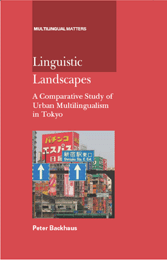
Einzelheiten
2007, ISBN 1-85359-947-6, Multilingual Matters, Clevedon(UK), 158 S. [Bestellen]Autoren
Rezensionen
Linguistic Landscapes: A Comparative Study of Urban Multilingualism in Tokyo Journal of Sociolinguistics 12/2
S. 250-254
Peter Backhaus: Linguistic Landscapes: A Comparative Study of Urban Multilingualism in Tokyo Language Policy 7/2
Linguistic Landscapes: A Comparative Study of Urban Multilingualism in Tokyo SKY Journal of Linguistics 20
S. 455-465
Linguistic Landscapes: A Comparative Study of Urban Multilingualism in Tokyo Pacific Affairs 80 (3)
S. 521-522
Linguistic Landscapes: A Comparative Study of Urban Multilingualism in Tokyo

Linguistic Landscapes is the first comprehensive approach to a largely under-explored sociolinguistic phenomenon: language on signs. Based on an up-to-date review of previous research from various places around the world, the book develops an analytical framework for the systematic analysis of linguistic landscape data. This framework is applied to a sample of 2,444 signs collected in 28 survey areas in central Tokyo. Analytical categories include the languages contained and their combinations, differences between official and nonofficial signs, geographic distribution, availability of translation or transliteration, linguistic idiosyncrasies, and the comparison of older and newer signs, among others. Combining qualitative and quantitative methods, the analysis yields some unique insights about the writers of multilingual signs, their readers, and the languages and scripts in contact. Linguistic Landscapes thus demonstrates that the study of language on signs has much to contribute to research into urban multilingualism, as well as the study of language and society as a whole.
Contents
Foreword by Bernard Spolsky
- Introduction
- Semiotic background and terminology
- Previous approaches to the linguistic landscape
- Summary
- Case study: Signs of multilingualism in Tokyo
- Conclusions